Numerical and Experimental Study on the Internal Flow of the Venturi Injector
Abstract
1. Introduction
2. Experimental Setup
3. Analysis Model
4. Mesh and Boundary Conditions
4.1. Mesh Independence Study
4.2. Comparison of Turbulence Models
4.3. Boundary Conditions
5. Results and Discussion
5.1. Comparison of the Numerical and Experimental Results
5.2. Analysis of the Mixing Process
5.3. Development of Cavitation Distributions
5.4. Development of Pressure and Velocity Distributions
5.5. Analysis of the Local Pressure Ratio
5.6. Development of the Turbulent Kinetic Energy
5.7. Development of the Volume Fraction of the Suction Flow
6. Conclusions
Author Contributions
Funding
Conflicts of Interest
References
- Ryan, J.; Saleh, M. Use of phosphorus fertilizers in pressurized irrigation systems: Problems and possible solutions. In Natural Resource Management Program; Alexandria University: Alexandria, Egypt, 1998. [Google Scholar]
- Kong, L.; Fan, X. Analysis on the influencing factors of throat negative pressure for Venturi injector. Agric. Res. Arid Areas 2013, 31, 78–82. [Google Scholar]
- Li, J.; Hong, T.; Feng, R.; Yue, X.; Luo, Y. Design and experiment of Venturi variable fertilizer apparatus based on pulse width modulation. Trans. Chin. Soc. Agric. Eng. 2012, 28, 105–110. [Google Scholar]
- Jin, Y.; Xia, C.; Fang, B. Research and Development of Venturi Fertilizer Applicator Series. China Rural Water Hydropower 2006, 5, 14–16. [Google Scholar]
- Fan, X.; Kong, L. Relationship of energy conversion for Venturi injector. J. Drain. Irrig. Mach. Eng. 2013, 31, 528–533. [Google Scholar]
- Han, Q.; Huang, X.; Liu, H.; Wu, W.; Fan, Y. Comparative Analysis on Fertilization Performance of Six Venturi Injectors. Trans. Chin. Soc. Agric. Mach. 2013, 44, 113–117. [Google Scholar]
- Yan, H.; Chu, X.; Wang, M.; Ma, Z. Injection performance of Venturi injector in micro-irrigation system. J. Drain. Irrig. Mach. Eng. 2010, 28, 251–255, 264. [Google Scholar]
- Feitosa Filho, J.C.; Botrel, T.A.; Pinto, J.M. Performance of the venturi type injectors joined to pipe under free and pressurized flow. Eng. Agric. 1998, 17, 20–35. [Google Scholar]
- Lima Neto, I.E.; de Melo Porto, R. Performance of Low-Cost Ejectors. J. Irrig. Drain. Eng. 2004, 130, 122–128. [Google Scholar] [CrossRef]
- Ozkan, F.; Ozturk, M.; Baylar, A. Experimental investigations of air and liquid injection by venturi tubes. Water Environ. J. 2006, 20, 114–122. [Google Scholar] [CrossRef]
- Parish, R.L.; Rosendale, R.M.; Bracy, R.P. Fertigation Uniformity Affected by Injector Type. Horttechnology 2003, 13, 103–105. [Google Scholar]
- Li, J.; Meng, Y.; Li, B. Field evaluation of fertigation uniformity as affected by injector type and manufacturing variability of emitters. Irrig. Sci. 2007, 25, 117–125. [Google Scholar] [CrossRef]
- Ye, S.; Zhang, J.; Xu, B.; Zhu, S. Theoretical investigation of the contributions of the excitation forces to the vibration of an axial piston pump. Mech. Syst. Signal Process 2019, 129, 201–217. [Google Scholar] [CrossRef]
- Zhu, Y.; Qian, P.; Tang, S.; Jiang, W.; Li, W.; Zhao, J. Amplitude-frequency characteristics analysis for vertical vibration of hydraulic AGC system under nonlinear action. AIP Adv. 2019, 9, 035019. [Google Scholar] [CrossRef]
- Zhu, Y.; Tang, S.; Wang, C.; Jiang, W.; Yuan, X.; Lei, Y. Bifurcation Characteristic research on the load vertical vibration of a hydraulic automatic gauge control system. Processes 2019, 7, 718. [Google Scholar] [CrossRef]
- Zhu, Y.; Tang, S.; Quan, L.; Jiang, W.; Zhou, L. Extraction method for signal effective component based on extreme-point symmetric mode decomposition and Kullback-Leibler divergence. J. Braz. Soc. Mech. Sci. Eng. 2019, 41, 100. [Google Scholar] [CrossRef]
- Yan, H.; Chen, Y.; Chu, X.; Xu, Y.; Wang, Z. Effect of structural optimization on performance of Venturi injector. In Conference Series: Earth and Environmental Science; IOP Publishing: Bristol, UK, 2012; Volume 15, p. 072014. [Google Scholar]
- Sun, Y.; Niu, W. Simulating the Effects of Structural Parameters on the Hydraulic Performances of Venturi Tube. Model. Simul. Eng. 2012, 2012, 1–7. [Google Scholar] [CrossRef][Green Version]
- Baylar, A.; Aydin, M.C.; Unsal, M.; Ozkan, F. Numerical modeling of venturi flows for determining air injection rates using FLUENT V6. 2. Math. Comput. Appl. 2009, 14, 97–108. [Google Scholar]
- Qian, J.Y.; Chen, M.R.; Liu, X.L.; Jin, Z.J. A numerical investigation of the flow of nanofluids through a micro Tesla valve. J. Zhejiang Univ. Sci. A 2019, 20, 50–60. [Google Scholar] [CrossRef]
- Nguyen, T.; Devaraj, V.D.M.; Albert, V.D.B.; Eijkel, J.C.T. Investigation of the effects of time periodic pressure and potential gradients on viscoelastic fluid flow in circular narrow confinements. Microfluid. Nanofluid. 2017, 21, 37. [Google Scholar] [CrossRef]
- Wang, C.; Hu, B.; Zhu, Y.; Wang, X.; Luo, C.; Cheng, L. Numerical study on the gas-water two-phase flow in the self-priming process of self-priming centrifugal pump. Processes 2019, 7, 330. [Google Scholar] [CrossRef]
- Wang, C.; He, X.; Zhang, D.; Hu, B.; Shi, W. Numerical and experimental study of the self-priming process of a multistage self-priming centrifugal pump. Int. J. Energy Res. 2019, 43, 4074–4092. [Google Scholar] [CrossRef]
- Lu, Y.; Zhu, R.; Wang, X.; Wang, Y.; Fu, Q.; Ye, D. Study on the complete rotational characteristic of coolant pump in the gas-liquid two-phase operating condition. Ann. Nucl. Energy 2019, 123, 180–189. [Google Scholar]
- Wang, C.; Chen, X.; Qiu, N.; Zhu, Y.; Shi, W. Numerical and experimental study on the pressure fluctuation, vibration, and noise of multistage pump with radial diffuser. J. Braz. Soc. Mech. Sci. Eng. 2018, 40, 481. [Google Scholar] [CrossRef]
- Wang, C.; He, X.; Cheng, L.; Luo, C.; Xu, J.; Chen, K.; Jiao, W. Numerical simulation on hydraulic characteristics of nozzle in waterjet propulsion system. Processes 2019, 7, 915. [Google Scholar] [CrossRef]
- He, X.; Jiao, W.; Wang, C.; Cao, W. Influence of surface roughness on the pump performance based on Computational Fluid Dynamics. IEEE Access 2019, 7, 105331–105341. [Google Scholar] [CrossRef]
- Nguyen, T.; Tran, T.; De Boer, H.; Albert, V.D.B.; Eijkel, J.C. Rotary-atomizer electric power generator. Phys. Rev. Appl. 2015, 3, 034005. [Google Scholar] [CrossRef]
- Huang, X.; Li, G.; Wang, M. CFD simulation to the flow field of Venturi injector. In Proceedings of the International Conference on Computer and Computing Technologies in Agriculture II, Volume 2, Beijing, China, 18–20 October 2009; pp. 805–815. [Google Scholar]
- Wang, M.; Huang, X.; Li, G. Numerical simulation of characteristics of Venturi Injector. Trans. Chin. Soc. Agric. Eng. 2006, 22, 27–31. [Google Scholar]
- Yan, H.; Wang, Z.; Chen, Y. High-speed photography analysis on cavitation of Venturi injector. J. Drain. Irrig. Mach. Eng. 2014, 32, 901–905, 920. [Google Scholar]
- Zwart, P.J.; Andrew, G.G.; Thabet, B. A two-phase flow model for predicting cavitation dynamics. In Proceedings of the Fifth international conference on multiphase flow, Yokohama, Japan, 30 May–4 June 2004; p. 152. [Google Scholar]
- Simpson, A.; Ranade, V.V. Modeling hydrodynamic cavitation in venturi: Influence of venturi configuration on inception and extent of cavitation. AIChE J. 2019, 65, 421–433. [Google Scholar] [CrossRef]
- Shi, H.; Li, M.; Nikrityuk, P.; Liu, Q. Experimental and numerical study of cavitation flows in venturi tubes: From CFD to an empirical model. Chem. Eng. Sci. 2019, 207, 672–687. [Google Scholar] [CrossRef]
- Dastane, G.G.; Thakkar, H.; Shah, R.; Perala, S.; Raut, J.; Pandit, A.B. Single and multiphase CFD simulations for designing cavitating venturi. Chem. Eng. Res. Des. 2019, 149, 1–12. [Google Scholar] [CrossRef]
- Brinkhorst, S.; Lavante, E.V.; Wendt, G. Experimental and numerical investigation of the cavitation-induced choked flow in a herschel venturi-tube. Flow Meas. Instrum. 2017, 54, 56–67. [Google Scholar] [CrossRef]
- Bashir, T.A.; Soni, A.G.; Mahulkar, A.V.; Pandit, A.B. The CFD driven optimisation of a modified venturi for cavitational activity. Can. J. Chem. Eng. 2011, 89, 1366–1375. [Google Scholar] [CrossRef]
- Ashrafizadeh, S.M.; Ghassemi, H. Experimental and numerical investigation on the performance of small-sized cavitating venturis. Flow Meas. Instrum. 2015, 42, 6–15. [Google Scholar] [CrossRef]
- Saharan, V.K. Computational study of different venturi and orifice type hydrodynamic cavitating devices. J. Hydrodyn. Ser. B 2016, 28, 293–305. [Google Scholar]
- Wang, C.; Wang, M.; Yu, Y.; Wang, L.; Wei, W. CFD Simulation of Venturi Tube Hydraulic Cavitation. Pipeline Tech. Equip. 2013, 1, 10–12. [Google Scholar]
- Wang, Y.; Zhao, L.; Deng, C.; Zhu, M.; Chen, P.; Su, H.; You, X. Numerical simulation of cavitation effect of the composite cavitation generator based on the Orifice plate and Venturi tube. Environ. Eng. 2012, S2, 458–460. [Google Scholar]
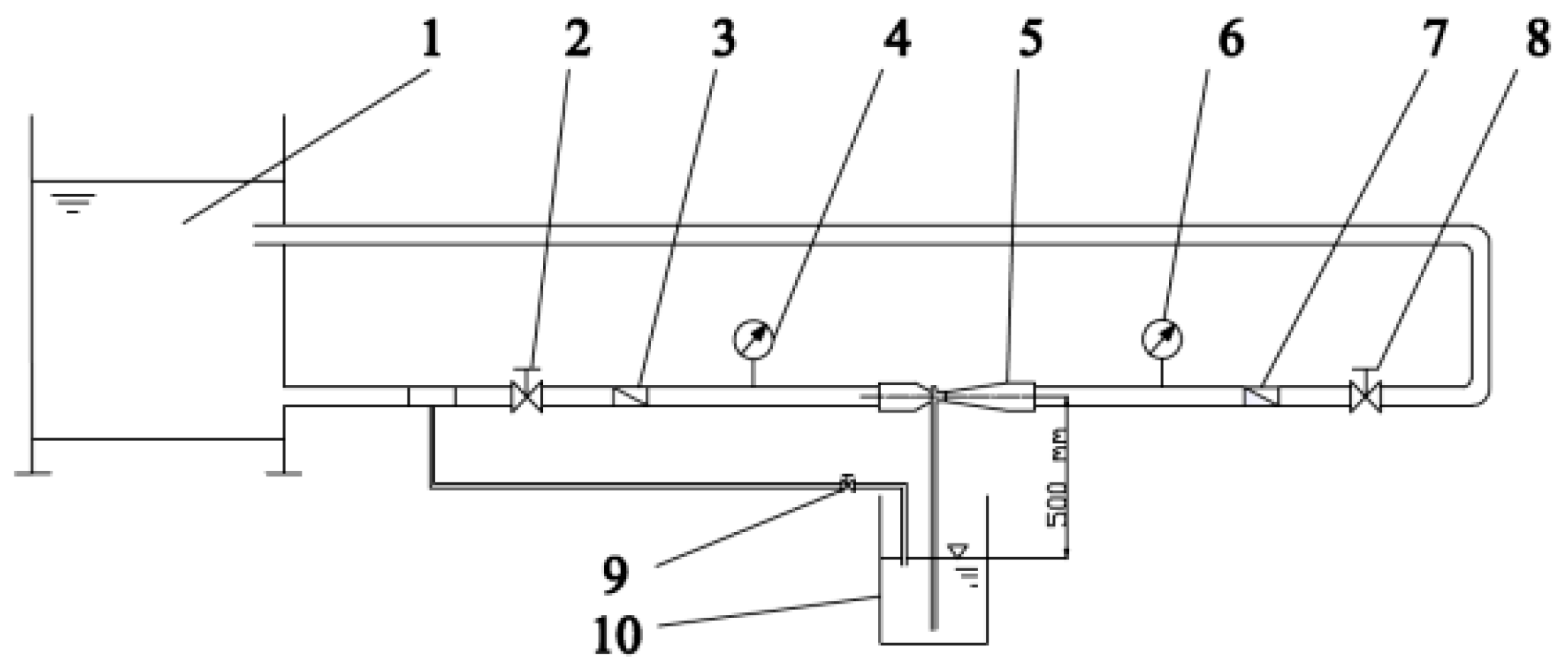
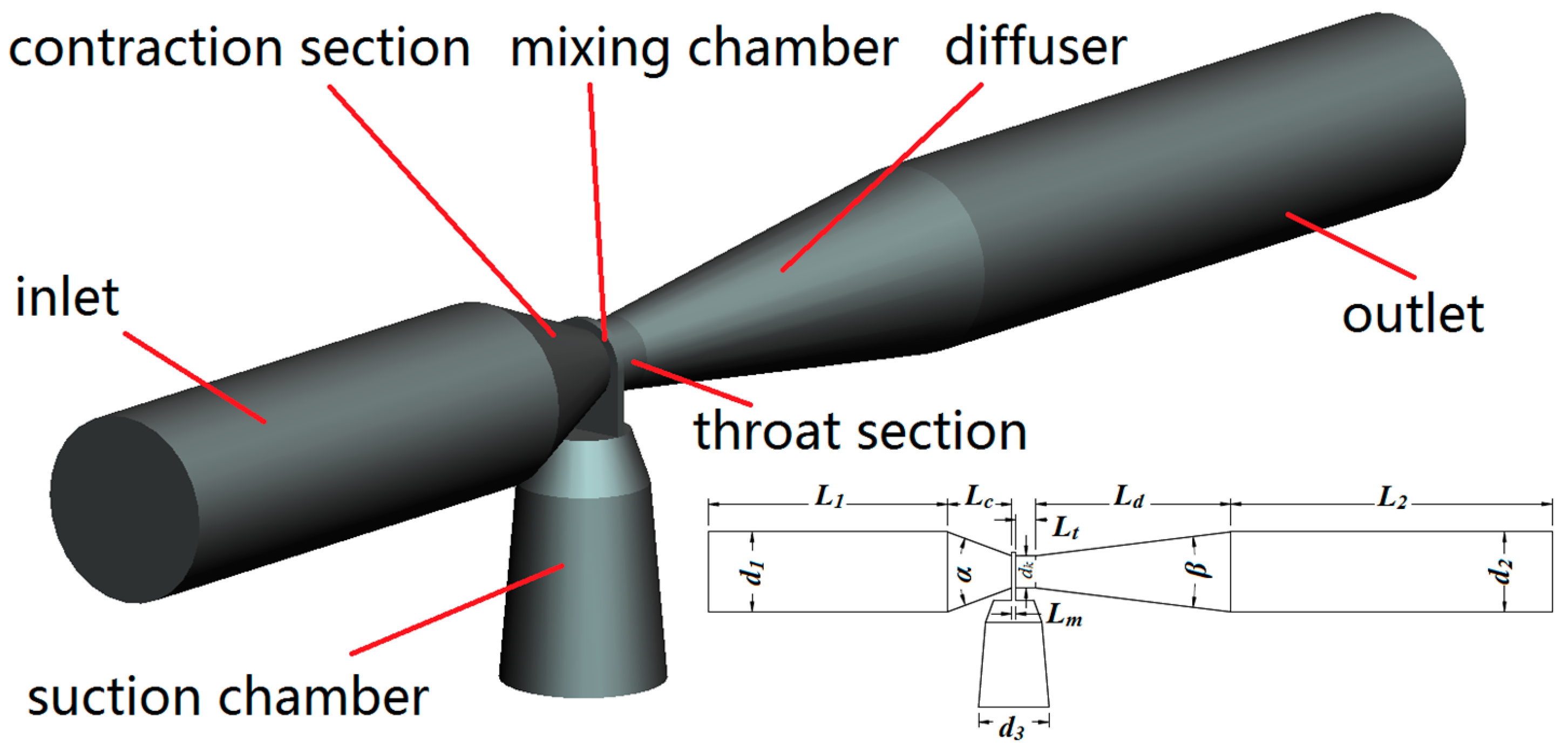
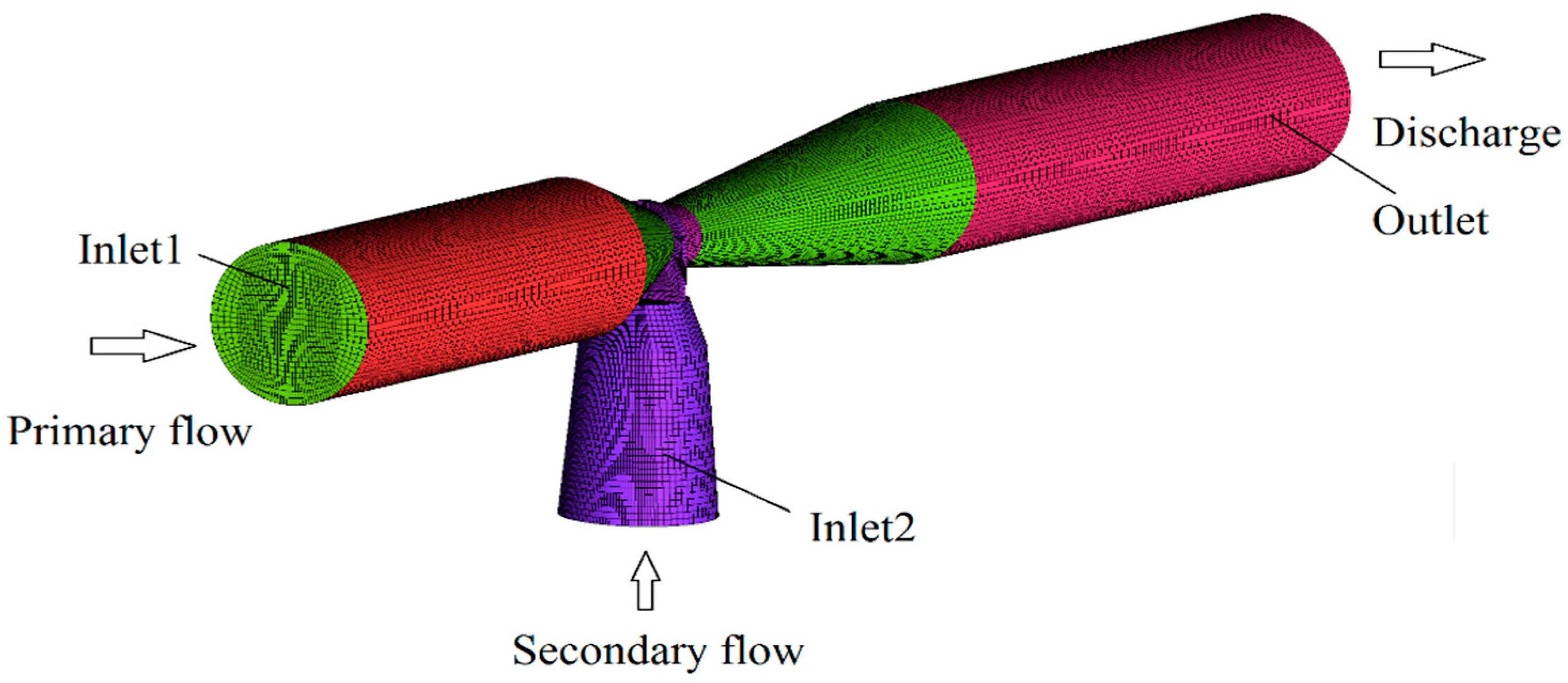






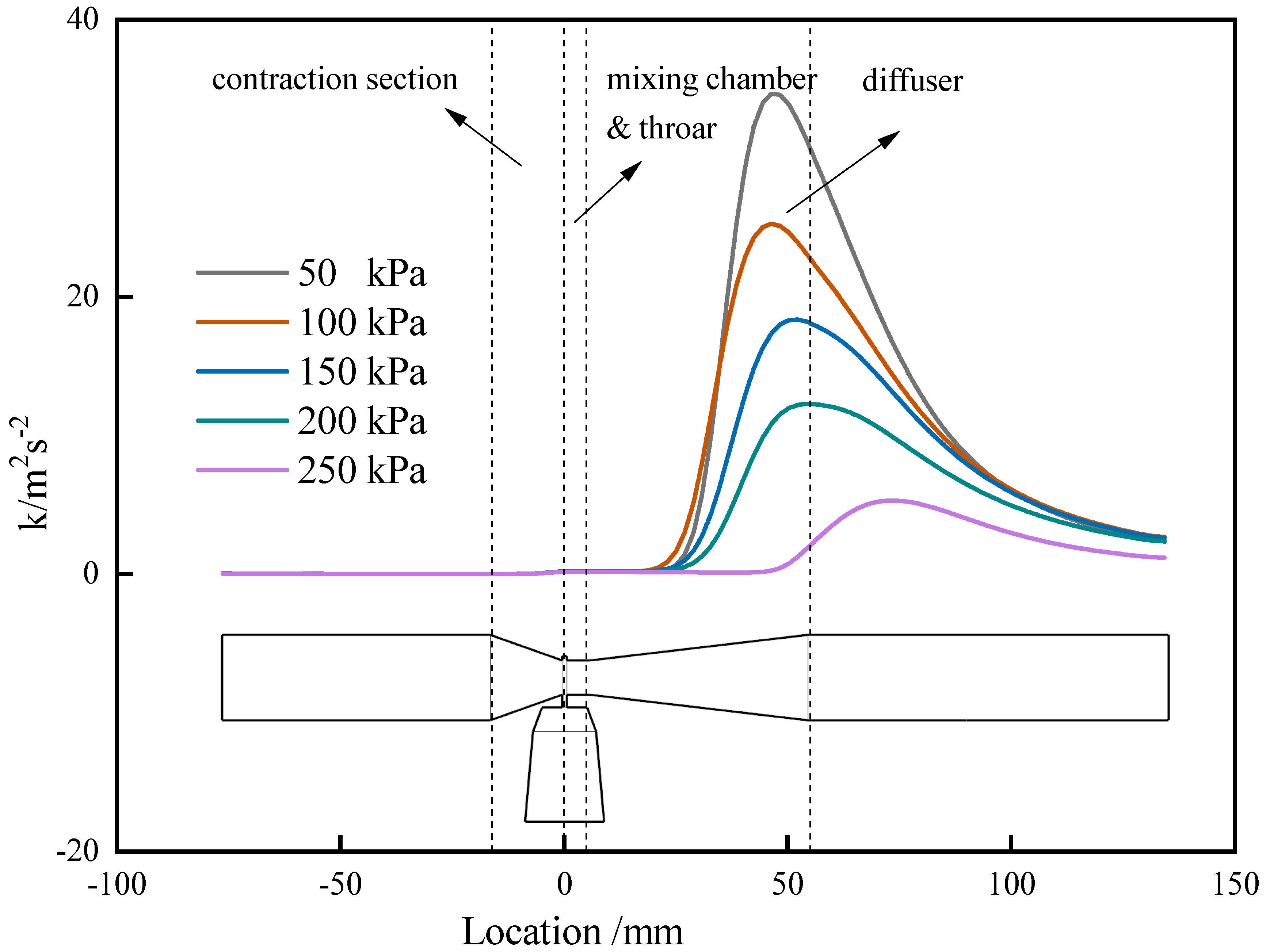
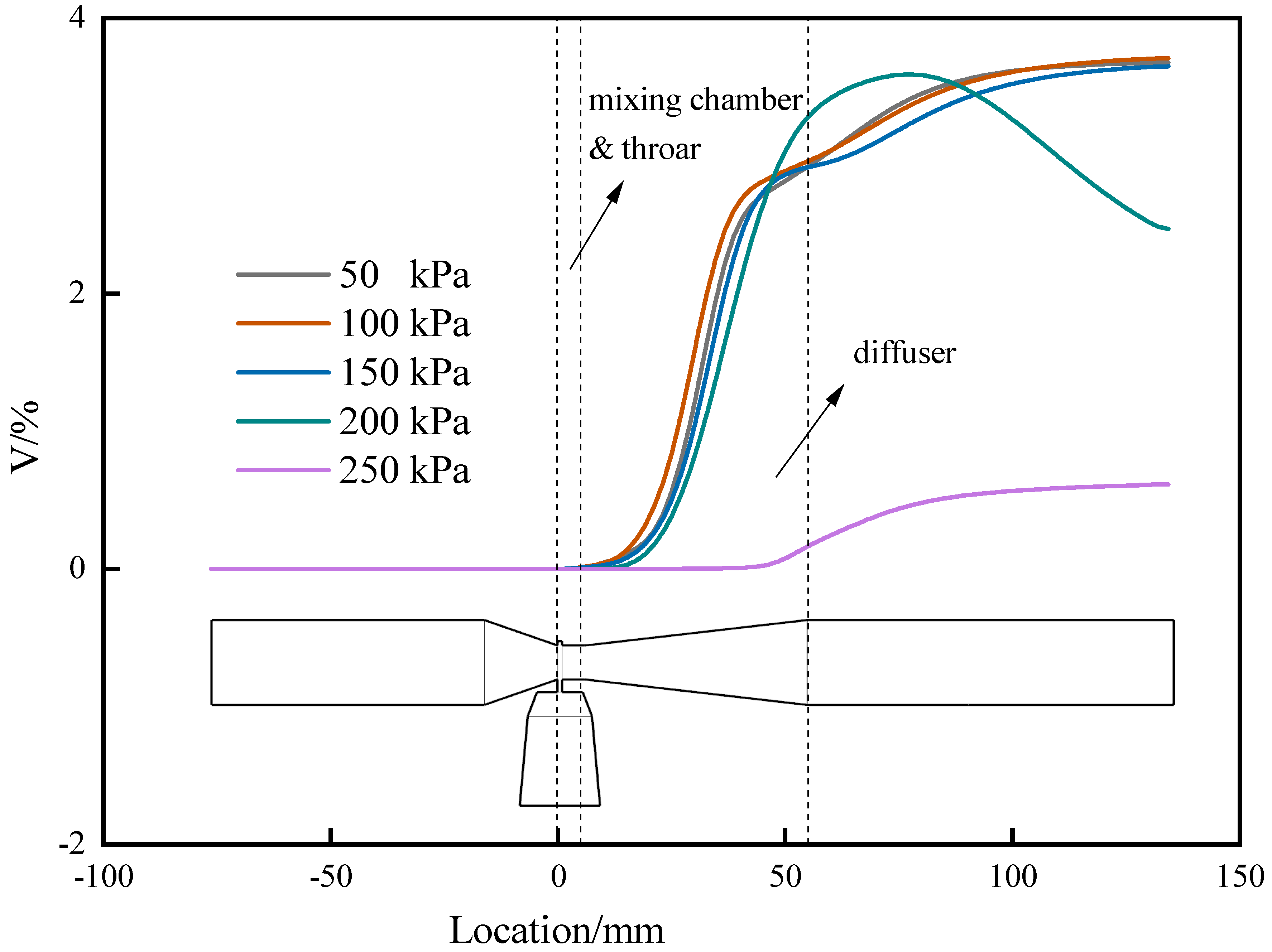
| Geometric Parameter | Value | Geometric Parameter | Value |
|---|---|---|---|
| Inlet diameter d1 (mm) | 20 | Inlet length L1 (mm) | 59.5 |
| Outlet diameter d2 (mm) | 20 | Outlet length L2 (mm) | 80 |
| Throat diameter dt (mm) | 8 | Contraction section length Lc (mm) | 16 |
| Suction diameter d3 (mm) | 17.5 | Mixing chamber length Lm (mm) | 1 |
| Contraction angle α (°) | 41 | Throat length Lt (mm) | 5 |
| Diffusion angle β (°) | 14 | Diffuser length Ld (mm) | 48.5 |
| Grid No. | 1 | 2 | 3 | 4 |
|---|---|---|---|---|
| Number of grid cells/104 | 20 | 30 | 40 | 60 |
| Q1/(m3/h) | 4.170418 | 4.200837 | 4.306605 | 4.320276 |
| Qs/(m3/h) | 0.166950 | 0.186685 | 0.239519 | 0.243264 |
| Grid No. | Standard k–ε | RNG k–ε | Realizable k–ε | Standard k–ω | Test Value |
|---|---|---|---|---|---|
| Q1/(m3/h) | 4.306605 | 4.322436 | 4.305457 | 4.352721 | 4.32 |
| Qs/(m3/h) | 0.239519 | 0.186685 | 0.18506 | 0.165261 | 0.21 |
| P1 (kPa) | P2 (kPa) | ΔP (kPa) | Q1 (m3/h) | Qs (m3/h) | q |
|---|---|---|---|---|---|
| 350 | 50 | 300 | 4.3066 | 0.2376 | 0.0552 |
| 100 | 250 | 4.3066 | 0.2396 | 0.0556 | |
| 150 | 200 | 4.3057 | 0.2372 | 0.0551 | |
| 200 | 150 | 4.0651 | 0.1912 | 0.0470 | |
| 250 | 100 | 3.7182 | 0.0284 | 0.0076 |
© 2020 by the authors. Licensee MDPI, Basel, Switzerland. This article is an open access article distributed under the terms and conditions of the Creative Commons Attribution (CC BY) license (http://creativecommons.org/licenses/by/4.0/).
Share and Cite
Li, H.; Li, H.; Huang, X.; Han, Q.; Yuan, Y.; Qi, B. Numerical and Experimental Study on the Internal Flow of the Venturi Injector. Processes 2020, 8, 64. https://doi.org/10.3390/pr8010064
Li H, Li H, Huang X, Han Q, Yuan Y, Qi B. Numerical and Experimental Study on the Internal Flow of the Venturi Injector. Processes. 2020; 8(1):64. https://doi.org/10.3390/pr8010064
Chicago/Turabian StyleLi, Hao, Hong Li, Xiuqiao Huang, Qibiao Han, Ye Yuan, and Bin Qi. 2020. "Numerical and Experimental Study on the Internal Flow of the Venturi Injector" Processes 8, no. 1: 64. https://doi.org/10.3390/pr8010064
APA StyleLi, H., Li, H., Huang, X., Han, Q., Yuan, Y., & Qi, B. (2020). Numerical and Experimental Study on the Internal Flow of the Venturi Injector. Processes, 8(1), 64. https://doi.org/10.3390/pr8010064





